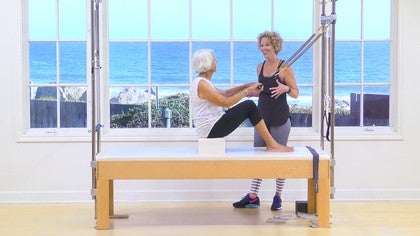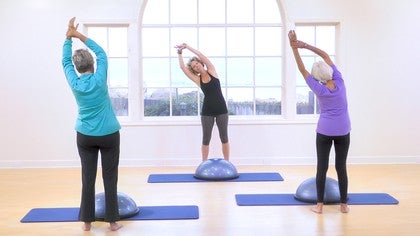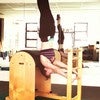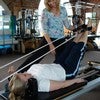Description
About This Video
Transcript
Read Full Transcript
Get excited. I'm Erica quest in case you don't know me, I am here with the most amazing 78 almost 79 year young Helen and we are going to take you through a trapeze class for the activate jurors. So you ready? Yes. Great. Let's go ahead and stand up and Helen, I'm going to have you stay right about where you're at and give me a little bit of a wider base of support with your feet so that you feel comfortable and you can give me just a little soft bend to the knees so that you feel good here. And the first thing we're going to do is just lift the arms up. So just notice what's happening here and then just lower the arms all the way back down and you can follow me or you can smile at the camera or smile at the person at home, the activator that's doing this with us and lower the arms down. Good.
And inhale, take the arms up and exhale all the way down. Good. And paying attention to really what's happening on in through your spine and all the way down. On this. Next one. Take the arms up above the head, hold them there. If you can grab onto your left wrist and pull yourself over to the right just a little bit, not a ton, just a little good. And then bring it back home. So feel how your body feels.
Side bending and then all the way wide and down here with me. Yes. Good. And lift the arms. Good. Grab on to that wrist with your left hand and see how your other side feels. So we're going through a slower, more systemic warmup for the body here. It feels good as we're actively ageing to just take things a little bit slower in the warm up. Let's do one more side, Ben, from side to side so that we give ourselves time to see how we feel before we go into some more challenging movement patterns and lift and from day to day, moment to moment. And from minute to minute we wake up and we feel differently.
So it's important to make sure that we check in on our system and all the way down you're ready to rotate so the arms come up. Rotate the palms of the hands up. And then from here we're gonna spiral around the spine just a little and just start a little rotation, seeing that beautiful Pacific Ocean and come back to center and then over to the other side. Yes, it doesn't have to be big. Good. And since that pole is in the way, Helen, let's make your arms do a goalpost. So come in and then we'll come back to center and will rotate.
And let's do one more set of these. So rotating, overlooking, spiraling that cervical spine, but taking it slower to make sure that you can turn around and see somebody in your bylined spot while you're and back center. And then lower the arms back down from here. Place the hands on the thighs, slide your hands towards your knees and bend your knees a little good hold. And then stand it all the way back up from here. Do that again. Bend your knees slightly. Slide the hands down.
Now from here, can you round your spine ever so slightly? If it feels good to you, do it. If it doesn't or it's not right for you or what's going on with you, then don't. And then extend the spine. Good and then try and round it a little good and then extended a little and two more times and round. Good and extend.
Good and nicely done. Last one and a little bit of extension. Stand yourself back up and let's warm up the digits. Those are your fingers by the way. Arms reach forward from here. Just touch thumb to four finger and open some to middle finger and open and some to ring finger. Open some to Pinky, finger and open. Reverse some to pinky open.
Really good for arthritis and ring. Really good for carpal tunnel. Pink or middle finger and open jazz hands and four finger and open. Let's do two more sets. I'm giving you arm work at the same time, believe it or not, some to forefinger and open. Thumb to middle and open some to ring and open some to Pinky and open.
Reverse Pinky, open, ring, open, middle, open and forefinger and shake it out. Good job. Let's move over to the push through bar. I will come around over on the other side. Now we're going to begin. I want you to hold onto the bar now. Feet are about hip distance apart, so you're very secure here.
Standing, holding onto the bar and the first thing we're going to do is just raise the heels up. Yes. And then lower them back down. Good. Pressing through the big toe and the toe right next to it. Good again and lift and lower. And just starting to really get that link through the top of the crown of the head. Lower carry on and lift and lower. Good. Four more. Yes, and lower down. You're doing great.
Three good. And two, some nice articulation through the feet and last one. Good. Now from here we're going to lift the right heel up. Good. Then you rise up on to both sets of toes and then switch. Good. And up and switch. So just feeling some prancing here or jogging rather if you want to call it that. As you move through. Articulation of the soles of the feet, finding the big toe and the toe next to it.
Now carrying on with this and noticing if the toes feel stiff or maybe you have a little arthritis, maybe one moves better than the other or not. Don't judge yourself. Just enjoy it. Five more. Good bore three, two and one good. Helen, now put both feet down and I want you to walk your feet a little bit wider. [inaudible] and now from here all I want you to do our some nice easy knee bend, so slight knee bend here and straighten. So we're starting to flex at the ankle joint a little bit more here as well.
Carry on. Focusing on that anterior Tibialis, the front of the Shin here, critical for fall prevention and reaction time. It also helps strengthening that muscle to combat what they call the senior shuffle. But I don't like the term senior. Senior is out. It is active ager. Good. Helen, you're doing great. Carry on with these. Now the first three digits of my cell phone number keep moving are eight four, two. Can you say the first three digits of my cell phone number? Yes, you're correct.
The last four digits of my cell phone number are nine four zero zero what are they so smart? Do you remember the first three digits they had out loud? She does it, but that's okay. Then it's eight 42 what are the first three digits? Good. And maybe the last four digits, nine four zero zero perfect job. Go ahead and give those knee bends. Arrest. Walk your feet a little closer to one another and can you march your knees?
So transfer one weight to your one foot and lift the knee up. Put that foot back down and try the other side. Good. And put that foot down and try the other side. So standing single leg work here. We're transferring weight, starting to evaluate balance from side to side of the body. Changing our cog or our center of gravity.
Four more times for good and three well done. Two and last one you did super from here. I would like for you to go back to a wider base of support and slightly turn out from the hips. Yeah, not so big. Little bit narrower. That's great. Now from here, we want to activate the quadratus lumborum, these deep core muscles to help you again with all prevention and reaction time. So from here, soft bend of the knees, and from here you're going to transfer weight and lift one knee up and back down and over to the other side. Now in any of these exercises, so keep moving, Helen. You can take these to approach aggression.
Helen's just working with the knee bend. If you wanted to go into a deeper lunge or excuse me, a deeper squat, you could most certainly do that to challenge yourself, but it depends on what's happening in your body that given day. Good. And pull it up and lift. Nice. You got 43 more. Just kidding. Four and three and two.
You did great and last one. Perfect. Now Walk your feet a little narrower. Again, I want you to walk towards your bar, but bend your elbows. Now this is the one where we're going to take it into kind of like a superwoman. Okay? So you're going to reach your arms up, straighten your elbows, rise up onto your toes and lean slightly forward. And now she's activating the front and the back of the body. Good.
Lower the heels. You're doing great. Bend your elbows. Nice. So keep that. The bar right there from here. Straight in. The elbows rise up onto the toes. Yes. So the further you walk back, the more challenging. But she's going to stay right here. Lower the heels, bend the elbows and try it again. Straight knee elbows rise up onto the toes.
So she got her sandwich working right now from the front to the back of the body and the lower the heels and bend the elbows. Good. You got two more. You Ready? And lift the arms. Rise up, good and lower. And bend last one and rise up. Great job. And Lower and Ben. So that's super woman or super person. And now we take it into airplane. So you're going to straighten the elbows out.
And from here again, spinal stability. So we want core activation as she keeps the elbow straight and one leg comes back behind you slightly. Beautiful, and then that foot comes back to the floor, anchor that foot, and we do the other side. Now tip forward as much as you can feel comfortable doing. Yes, bring it back home. You can take this to a progression. Helen will stay right where she's at by just staying in this position.
But you could take it all the way forward to almost go flat towards the floor. Good. And bring it all the way back up. But the idea here is to really keep that nice tall spine and just to hinge at the hips. Good. And bring it back and do it again and out. Good. So you can see she's really having to find that stability of the hip to the need of the ankle and the leg that stands. Bring it back up and other side. Great job. Let's do two more so that your even, and you can see the more that she feels confident and comfortable, the more she's taking a bigger range of motion, like a rock star. Right?
This is what happens when you start to organize and transfer the learning. Good, Helen. So Nice. Excellent job. So from here, we're going to let go the push through bar. We are done on this side of the trapeze and we will move into the quadriped head position on the table. All right, we're moving into a quadruple head on the trapeze table. So Helen pump with me and phase the handles. I have the handles, the s a slide bars about two one third of the way down, two thirds of the way up. You can adjust it according to what feels good for you, um, and the tension that you want. We're on a yellow spring now. Before she moves, we want to make sure that the ham that is on the table is right underneath the shoulders. So you want to bring this back a little bit so that there's a good relationship from the shoulder all the way to the wrist. Now from here, we're going to work on a sling from the right hand to the left inner thigh muscle. She's going to exhale, pull that spring towards the left knee. Yes, and then reach it back forward. Keep doing that, Helen, you're doing great.
I like the pace and the tempo as well and forward. So she's connecting on the Anterior Oblique sling from the right arm pit all the way to the left inner thigh while she's stabilizing with the left shoulder. And you can see she has great shoulder stability on this side. Last two like this. Then we'll challenge things because she's almost 79 years young and appreciate the challenge. Good.
And from here you're gonna extend your right leg out. That's the opposite leg to the stub stabilizing shoulder. Now that right, excuse me, I am incorrect. Put that knee back down and extend your left leg long. So hope you heard that correction from here you're gonna bend your left knee and pull your right hand towards the left knee. Good. So again, we're throwing off the center of gravity. She's having to work hard, finding different muscles, intrinsic muscles to keep her body facing the table. If she didn't, then she would. A lot of things might be happening. Good. And if you don't, a lot of things might be happening to you last too and pulling in, but you're doing great. And last one and pull it in.
Staying stable through that spine. Great. Put this knee down. Take this hand out and we switch sides. Shake out your wrists if you need to. Now bring that hand back so it's stacked underneath the shoulder. Don't do anything with the leg quite yet. Just take the left hand, bring it over towards the right. Good.
And notice what feels different on this side. She's keeping the front and the back body fired up and turned on. We like to call this your spinal sandwich. Three more like that. And then we'll add in the leg. Good. And two, you do an okay, good. And one she says with a smile and arm reaches. Now the right leg goes long and changing. Center of gravity again, bend the right knee, bring the left hand to the right knee. Beautiful.
And then reach all the way out. So again, we're training balance in a different body position. It's very important to train balance in multiple different body positions because at the age of 30 our balance begins to go away two more times. So if we don't challenge it, we're going to lose it. And last one good. Take a break and give that arrest. It's been plenty of time on her knees so I want you to go ahead and safely come off to the floor and stand.
We're going to now move over onto the other side of the trapeze table and do some standing leg springs. Okay, so we've moved to the other side of the trapeze table. You've noticed that I've moved the slide bar down about halfway, maybe a little bit lower. Again, you have the gas pedal, so do what feels good for you. Tension wise you may need to make micro adjustments and that's okay. I'm using Purple Springs Balance Body for the leg springs and we're going to do some standing leg springs now so that we have room to move. I'm going to move a small box out into the equation and some grip on the floor so that it doesn't slide.
We are lined up so that we are biomechanically hip to knee to ankle in alignment. Helen, place your right foot on the box. Hold on to, sorry. Excuse me. Place your left foot on the box. She listens very well. Hold onto your uprights and I'm going to help you put your left, your right foot into the loop. Now before we begin the movement pattern, let's set the tone of the body.
So she's secure here. You're secure here. Holding onto the uprights. The spine is nice and tall, so I want you to really grow tall through the yes through the top of the crown of the head. Feel that axial elongation upwards. Now I want you to reach down through the foot that has the loop in it, in opposition, and activate the hamstring and press back. So she's activating her hamstring in her gluteal. Draw forward again. Good. And then press it back. Wonderful. So carry on with that.
So this is a familiar movement pattern. You can smile at any time. Press it back. So we're going to pour in a little bit of neuroplasticity again. So my favorite color is green. Can you spell the word green?
Correct. Can you spell the word blue backwards? You? Yes. So good. My other favorite color is purple. Don't worry, you don't have to spell it backwards. Can you spell it forward? Very good.
Now pause from here and begin some circles with the legs. So press back then circle around the hip and forward. So now we're not only moving in that front to back plane, the sagittal plane, we're doing a little bit of circumduction and hip mobilization here. Good. You're doing great. And try not to lose tension in the spring, which you're doing a fantastic job of two more times. And last one, reverse your direction and wide and around.
Good. And reaching back. Finding that hamstring, noticing if you've lost any of that height through the spine or any of that core activation. Good. And three more. Super. Two and one you did great. So of course we have to do the other side. So let's get that foot out. Take a step down. I will move your box over to the other side and then you can lather, rinse, repeat, right? So right foot goes up, you grab onto the Poles and I will help you load that left foot in.
So again, lets you good, let's set up for success. So feel that Nice, strong hold on your uprights, lift through the top of the crown of the head, reach down through that, left sole of the foot and press back. Good and draw forward. Now, one leg is a stabilizing leg. One leg is a mobilizing leg, so the right leg is your stabilizing leg that's on the box right now. So it might start to get a little bit fatigued, but the back of the leg and the gluteal on the mobilizing leg are also being challenged. Really good for gait training and reaching down and pressing back. Good. And for more super carry on.
Three more. You're going to do your circles after two and one so press back again and then circle away from the body and forward. Nice and forward. Good press circling around, keeping the chest nice and tall. Good.
And for super three. So as a reminder, the last four digits of my cell phone number are nine four zero zero. Reverse your direction of circle. What are the last four digits of my cell phone number? Four Oh, so good. The first three are eight four two. What are the first three? Eight. Four, two.
And can you add eight, four and two together? Yeah, keep moving. Good. Very good. Keep moving. That's great. Whoa. You speed it up on me. You got to slow that down. Good. That's the brain moving. You know it's okay. And you reverse direction. So go out.
So come back around, reach the leg wide and come back around and through. Good am for. So we're playing with the right brain and the left brain applying movement last to good. And last one. You did a great job. Good. So let's get this foot out. Take a step down onto the floor. We're done with this small box for now. I'll bring it back out. Actually. Yes, I'll bring it back out in just a moment.
Willing to lift the bar up and we're going to take some standing chest expansion. And I'm going about about 50 50, 50 on from the table to a the uprights. But you are the risers at the top, but you can do whatever feels best for you. So come full. Come over here Helen, and pick up your handles. Uh Huh. Now I want you to have about a hip distance apart.
Parallel stance. Don't lock out the knees. Now you're going to do some standing chest expansion. You got to really use your core here, your sandwich as well. Remember, you have a piece of bread on the front piece of bread on the back and I'm squishing you together. Okay, so inhale to prepare. Exhale, press into the palms of the hands. Activate the posterior side of the body. Feel these nice, Taut ads, which I do feel. Inhale forward and exhale. Do it again. Press.
Now think about this. Can you reach down through the fingers to get taller through the spine? Good. I saw something happen. Great and forward. Getting that element of float through the body. So as if I had your rib cage in my hands, I'd be lifting your rib cage up off of your waist.
But you do that and reach down and press back however the backs of the arms getting [inaudible] warm. Yeah, they get evil arm and three more good and two. Well done. And now last thing to do. Hold. You're going to be a little hummingbird and you're going to give me little hummingbird presses back. That's going to again throw off the center of gravity. My friend Valentine, she likes to call this something very funny, but I'm just going to call it your hummingbird. Arm's good.
She calls it perturbation. Good. Four, three, two and one. Go ahead and arrest the backs of those arms should feel nice and warm. Super. So we're going to lift this slide bar up again to work the lateral line of the body, the side body, because the body is a three dimensional platform and it needs to be moved in all different mobilized and stabilized and all different body positions. So standing, you're going to put your right hand into the loop. Turn and face this direction. Step.
Take a mini step back towards me. Yes, and widen out your feet a little bit. Now from here, the left hand comes up to the ceiling. I've put an imaginary pink grapefruit underneath this right arm pit. You're going to juice that pink grapefruit and you're going to not lean arch up and over good and bring it back. So juice your grapefruit, squeeze it down, and then arc over and then bring it back up. So she's connecting deeper with the right line of the body and lengthening out the left line of the body. Good. And four more.
Good. And lifting and juice like grapefruit and arch. Good and two and press down archiving, feeling that link through the left fingertips all the way down to the left foot. And one before we do the other side, we want to do one more exercise or game on this side. So go ahead and give that arrest. Telling this left arm comes down, take a step over towards the handle and you're going to frame the face with the handle. Yes. So now from here we look pretty good. You might want to take a mini step over away from so other direction. Yes.
And now this elbow is going to bend towards this hip. Yes. So now we're going in the opposite direction, stretching out the side that's closer to the trapeze and connecting deeper with the side that is not okay. So noticing what's different between each exercise and then we'll notice what's different on the other side of the body when we turn around. But she's flexing laterally. There's a pane of glass here. There's a pane of glass here. There's no breaking.
It's movement in between those two. Last two good and last one here. Excellent job. So now we have to do the other side. So you will turn and face me. Great. We're going to start with the hand suspended into the handle.
So why now those feet a little bit. Take your arm up to the ceiling. Good. Remember you got your grapefruit right here, right? And you're going to juice the grapefruit and arc over. Good. And then bring it back up and do it again. Juice that grapefruit and AHRQ. Nice. And bring it back home.
Yeah, so she's late. Thinning out that whole kinetic chain on that side as she's connecting a little deeper on this side that's closest or the side that's closest to your trapeze table. Two more. And here we go. That should be about even might be a tiny bit off, so I apologize. I'm usually super good at my counting. Good. And then now we're going to frame the face. So you want to walk this direction a little. Keep that, that little bit of wider base of support here just helps you with your, with your balance and from here, keep that left foot reaching to the floor as you come over with the right elbow [inaudible] so you're opening up that left side of the body and connecting with the right side and again, making micro adjustments, meaning moving closer, further the further away depending on the tension that you want. Good.
And bring it back up. Last four. Nice, good. And three, she caught it and two things are going to change. You got to more stay there and two things are going to change from side to side and last one, grow tall and arc over. Great job. Okay, so we're going to still use these handles but we're moving back to sitting on the trapeze table. Okay. We're moving into some seated games or exercises on the trapeze table.
Now I've elevated Helen up off of the trapeze. If you don't need this for your hip flexors or hamstrings, you can stay seated down on the table. I like to do this in a more stable spine. So you're going to sit up nice and tall. Helen, I'm going to hand these handles to you and we're going to begin with eight narrow row. So rotate the palms of the hands towards one another and lift up again through that spine. And then from here, bend your elbows in, pull back. Okay, good.
And draw forward and bend the elbows and pull back. And again, the further back, keep going. You move with the body or the box, the more challenging it's going to be with the tension in the springs. Good. And reaching forward and pulling back. Nice. And for more like this. So I don't want to hear the click of the spring. So reach forward just to there. And three pole back. Wonderful.
And two and one. Now we go to a wider row, palms down and bend those elbows wide. Good. And draw forward and bend those elbows wide. You keep moving. I'm going to tell you a story. Okay. So back in the day in the fall in southern California, when we had a hot, a hot or hot fall, hot winter, there was one where I could go to the market and make an apple crisp and I had to get eight green granny Smith apples. They cost me $8 and 42 cents. What kind of apples did I buy?
And do you remember what kind they were? Granny Smith? Yes. Can you spell green? Can you spell green backwards and Oh yes. Good. Two more. And last one. Now rotate the palms of the hands up and then that those elbows show him the guns and bring it back forward and do it again.
Good lifting up through that spine. You're doing great and pull good again. Don't hear that. Click of the spring if you can avoid it. Yes, super job. That means you're keeping tension. The muscles both East centric, Lee and consequently, and four more times four. She's strong and three. You feel strong?
Yes. Two, you look strong and one great job. Let's go ahead and let go of these handles. We're going to transition you, so go ahead. We're going to move you off the box, come off onto the table. You can just stay and swing your legs over to the side for a moment. I'm going to move the box down and lower the slide bar down just a little bit. We are gonna finish with a prone exercise or game and it's going to be called Eagle.
And from here you're going to be lying on your belly, Helen. And now remember we want to have your forehead on this small box so that the head stays in line with the heart and does not drop below the heart. Okay, so slide back a little so that you have a little bit of a better [inaudible] and then the hands are going to reach forward into these handles. So grab the handles and the arms are going to come onto the outsides of the bars. Now remember I called this Eagle, but I'm actually going to change it to swimming and or butterfly because I want you to feel like you're in a pool of water and you're going to do a butterfly repetitions. So make sure that the legs are a little wider. And I want you to slightly go a little heavier with your tailbone and pull your abs into your spine. But don't grip the glutes from here.
You're gonna make a circle with the arms and lift your head right here. Yes. And then reach the arms back forward and lower the forehead down. So she's circling press and lifting with the mid thoracics and then lowering. But you'll notice that the box is really helping because she's not having a drop that had forward. Okay. So that's really important here, especially when you are dealing with maybe somebody who had, has blood pressure issues, whether it be high or low blood pressure and or you have high or low blood pressure and there's no judgment on that. These exercises and games can still be performed. Two more. Helen.
Good. And last one. Very nice. Safely. Go ahead and let go of the handles and you can slowly bring your best self back up. And I just want you to sit on the trapeze table and let the legs dangle. Now it's important when we're moving from body position to body position that you take a little bit, take it a little bit slower, just so that transition time is okay for the cervical fluid, the vestibular system. Now follow me. You're just going to stay seated and I want you to lift your arms up. Good. And then I want you to bend your elbows and open your chest.
[inaudible] let the arms float back down. Good. And do it again. Let the arms float
So drawing the arms up and lower. Yes. And draw the arms up and lower. Good at up and lower. So we've done a few reacclimated exercises sitting. So go ahead and come to stand with me, Helen. Walk forward a little.
Now I, you need to be able to see me from here. I want you to reach those arms forward, bend the elbows and let the risks be totally soft. Okay, so we're going to work on bone health right now. We're going to imagine that we're a horse and all I want you to do is just start to bounce. Don't let the arms move, just bounce those heels and it's probably going to feel kind of fun so you can smile depending on how her toes are feeling or her knees are feeling. It is hard. Yes. Good. Five, four, three, two, and let your arms shake. Good. Now from here, lift those arms just slightly wider and the legs slightly wider and just give me a little rotation. Nice and slow. Let the arms be heavy.
Active Aging: Working on Neuroplasticity
Comments
I also love your reformer workouts with "P. Dog". So much fun how you integrate creative movements to the classical repertoire. Can't wait to see more:)
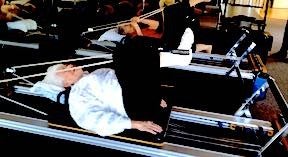
You need to be a subscriber to post a comment.
Please Log In or Create an Account to start your free trial.
